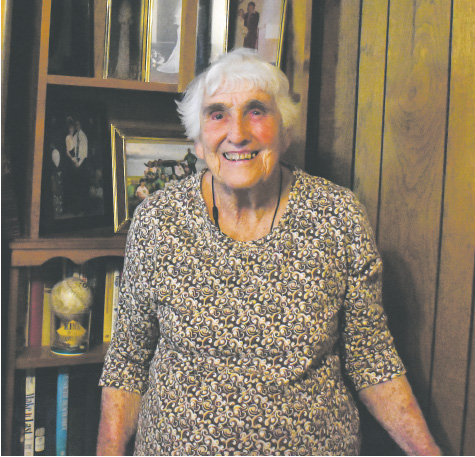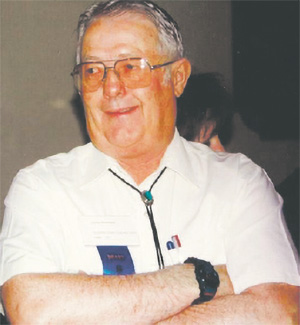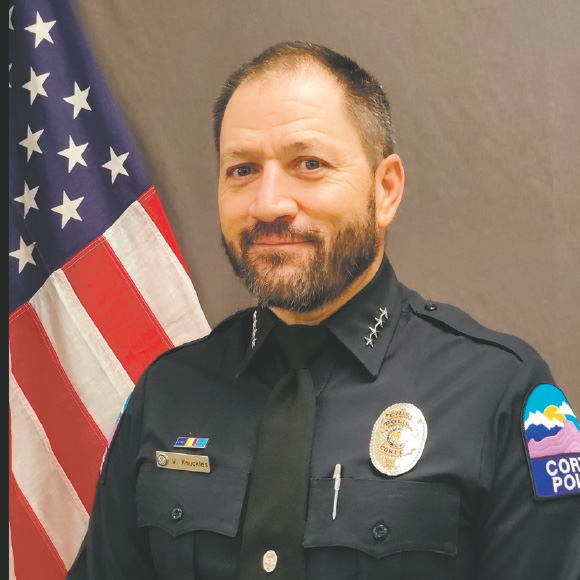
Vernon Knuckles became Cortez’s police chief at a time of widespread controversy over
law enforcement, but he is taking changes in stride. Photo courtesy of Cortez Police Department.
Anger, rudeness, and general bad behavior on the part of other human beings may be upsetting. People who are subjected to such hostility want something to be done to stop it, and they may call the police.
But can law enforcement be counted on to halt such behavior? Not necessarily, according to Cortez Police Chief Vernon Knuckles.
“People feel when they call the police that a crime has been committed against them, and sometimes that’s not the case,” Knuckles told the Four Corners Free Press in a phone interview. “Elements have to be met for a crime to have occurred. Sometimes they haven’t been met. A lot of times, even though it seems like you’re a victim of a crime, you’re not.”
That’s one of the main things ordinary citizens don’t always understand about police work, he said.
“People get kind of upset with us when we tell them charges can’t be filed,” he said. But even when an actual crime hasn’t been committed during a disagreement, police will still try to help, he added. “We will still make sure the situation is resolved as much as possible.”
In 2020 there were a number of such incidents, many involving the protests that took place on Saturdays in downtown Cortez. While some people marched in support of peace and justice as well as the Black Lives Matter movement, other folks drove up and down Main Street in vehicles waving not just American flags but flags for Trump, the Confederacy, the Three Percent militia movement, and more.
This sometimes led to skirmishes that involved shouting and heckling.
“With some of the protests this summer, the groups may have felt like the other side was assaulting them,” Knuckles said. “I got a lot of emails about verbally assaulting, but that’s not an assault. Assault is a physical thing. We would ascertain, was there harassment? Did the comments meet the elements? Sometimes it’s just some people are being hateful. Unfortunately, hateful is not a crime.”
Probably the most heated of those confrontations took place Jan. 2 of this year, when about 20 members of the group known as the Patriots, who usually stayed in their vehicles, surrounded five peace and justice marchers on the sidewalk downtown. A few in the patriot group shouted obscenities and hateful comments. Police drove by but none intervened, leading to criticism on social media.
Knuckles, who wasn’t present, watched a video of the incident and decided a crime had been committed in this case. Ultimately, six people were given summonses for harassment because they had followed the social-justice marchers as they walked away to try to avoid the conflict.
Yelling ‘fire’
However, most clashes between the different protest groups did not lead to charges. People do have freedom of speech, even if it means saying something rude or unpleasant, Knuckles said.
Of course that doesn’t mean freedom of speech is absolute. Knuckles noted that the old adage about not being able to “yell ‘fire’ in a crowded theater” still applies.
“The fire in the theater is likely to cause panic or disarray. It has the potential for injury,” he said. “It would be the same as yelling that there’s a bomb on an airplane.”
Another misconception citizens may have about police is what they can accomplish through forensics. Knuckles said he does not watch a great deal of television, but when it comes to police shows, there are a few that do a fairly good job of depicting police work. “The first 48 Hours. Then Forensic Files. Those are more like documentaries. NCIS.”
But some prime-time police shows present a highly unrealistic view of police work, with an enormous amount of lab time devoted to each case, he said.
“People that watch those think we can do those things, and it’s not true. All the technology.”
Even fingerprints aren’t as cut-and-dried a matter as might be believed, he said. While all police officers have the capability of taking a fingerprint from a scene, it has to be analyzed.
“Our CBI [Colorado Bureau of Investigation] won’t even look at a fingerprint unless it involves a homicide,” Knuckles said. Citizens expect police to go to the scene of a burglary and take prints, but someone has to be able to read them. “You have to be trained in fingerprint identification. I don’t believe we have anybody trained.”
Unjustified force
Knuckles became Cortez’s police chief in the spring of 2020, replacing Roy Lane, who had served in the position for 37 years before he quit because of ill health. He died in December 2019.
Knuckles’ appointment was announced by the city on May 18. One week later, the death of George Floyd under the knee of a Minneapolis police officer led to nationwide protests, riots, and calls for police reform. Knuckles took the reins of his job in mid- June, when law officers everywhere were facing increased criticism. He said he understands the outrage because George Floyd’s death was wrong.
“As soon as I saw that (video), I knew that the amount of force they were using was completely unjustified,” he said. “I thought, ‘There’s enough police standing around there that they would not need to be kneeling on him. They could have restrained him sitting up or even standing’.” However, Knuckles does not have a lot of sympathy for the Black Lives Matter movement as a whole.
“Nationally, I think the BLM movement has nothing to do with saving the lives of minorities. That’s my personal opinion,” he said. “There is zero concern for the number of inner-city black people that are being killed with black-on-black crime. The outrage comes from isolated incidents where a minority dies at the hands of a police officer, especially if the officer is Caucasian. It just makes me want to believe there’s some other motive behind that movement.”
But when it comes to the local protests, he has a different view.
“I think our group here truly wants to help out the minority community and believes that there have been some injustices locally with the minority population.”
When he first talked with the marchers, Knuckles said, he told them, “You’re walking under that BLM banner. When you turn on TV and see cities burning, people are associating you with that.”
The group was responsive, he said. “They still support the BLM but they took on ‘peace and justice’ and I think that helped a lot. I think they do support more than minority issues.”
The entire situation is complex and fraught with misunderstanding, he said. “It’s just so tough. I’ve been on a spit over the fire.”
The Jan. 2 incident in Cortez led to a Zoom meeting between Knuckles and local citizens, many involved with the peace and justice marches. The tone was cordial and the discussion ended on a positive note.
A new response
Knuckles has long been an advocate of an effort that’s related to what is misleadingly called “defunding the police.” While there are extremists who would like to see law enforcement agencies shrunk to near oblivion, most people recognize that law enforcement is needed in society. But often officers are called to deal with incidents that don’t involve crimes, and Knuckles would like to see that change.
He is working with other local agencies to get a program going where people other than law officers could respond to certain situations. Currently, if a citizen going to the grocery store sees somebody sitting outside in the freezing cold, they call police. The law is likewise called to handle mental-health crises that don’t involve weapons or crimes.
Knuckles envisions roaming units staffed with a mental-health counselor and an EMT that would instead respond to such calls. “If someone’s passed out in the park and someone is concerned, they could call that unit,” he said, “and they would help get those individuals to some services.” Knuckles said such “welfare checks” currently take up a lot of police time.
“I printed off all our welfare checks for 2020 with one per page, and there were reams of paper,” he said.
This would provide another option, and would free police to deal with other problems, though law enforcement still could show up on scene to make sure everything was all right.
The Cortez Police Department is in very early discussions with Axis Health, the Mancos Marshal’s Office, and the Montezuma Sheriff ’s office about how the program might work. A number of cities already have such programs in place that could serve as models, he said. “We don’t have to reinvent the wheel.”
It would probably not be in place until 2022, he said, but it would need to be well planned before then. “We need to have it pretty well set in stone by October so we can reach out to the commissioners and city council during budget time,” he said.
The program would probably involve an independent unit rather than a counselor riding around with the Cortez police. “We looked at the co-responder method, where a counselor might be with an officer, but we need the program to be more county-wide,” Knuckles said. “If the counselor is riding with Cortez police and something goes on in Dolores, it slows down the response.
“We felt a stand-alone unit that could roam would be better. They could do self-initiated contacts, go to the hot spots – City Market, Safeway, the park – maybe eliminate some of the calls that dispatch receives. Be proactive.”
Cortez does not see a great deal of extremely violent crime, but police do face danger on the job on a regular basis.
“The domestic calls are dangerous for law enforcement officers,” Knuckles said. “You have two individuals, typically in a relationship, that are both heated. They can turn on you.”
Colorado law requires that the perpetrator of domestic violence be arrested, if the facts indicate that someone was perpetrating violence. That means police may be removing the victim’s source of income and livelihood, Knuckles said. “That can get pretty heated and dangerous.”
Investigations and arrests involving illegal narcotics are potentially quite dangerous for officers, he said.
But most police encounters with citizens are peaceful. “Mostly, people are pretty compliant. The people that really get aggressive are probably the minority. Our officers are good at de-escalating and explaining things.”
Knuckles, who grew up in Egnar near the Utah border, began his law-enforcement career with the Dolores County Sheriff’s Office, where he worked from 1991 to 1994.
After a brief stint with Colorado parks in Grand Junction, he came to the Cortez Police Department, where he worked until 2005. He left to do contract work overseas in Iraq for four years, then returned to the area, working for the District Attorney’s office, then the sheriff ’s office as a narcotics officer. He eventually became undersheriff.
But his longest stint in law enforcement was the 11 years he had spent with the Cortez police, and he was glad to be able to return. “It’s really like I came home,” he said. “It felt pretty good. There were a lot of the same guys here.”
But taking over for Roy Lane was a little unsettling. “Roy mentored me. He helped me out when I was at the sheriff ’s office. He was here a long time. I knew there were big shoes to fill. It was a little strange.”
Knuckles is looking forward to moving law enforcement into the future. “I felt like Roy did an outstanding job for 37 years, but he was kind of set in his ways. I think I bring the opportunity to kind of bring the agency little bit forward, the way things are changing. I look at it as a positive thing.”
Changes to law enforcement
In response to the death of George Floyd and other incidents of police force that clearly seemed unjustified, Colorado became one of the first states in the nation to pass a sweeping reform bill, SB 217. It changed the rules under which law officers can use deadly force. It requires that they intervene if a fellow officer is using inappropriate force. It bans the use of chokeholds and carotid holds.
Knuckles said some of his officers were concerned about the new rules, but he believes the changes aren’t unreasonable. “Some of the older officers got really nervous. ‘You can’t do the job. It’s not real law enforcement.’
“All I have to say is, law enforcement has been changing forever. Police officers used to be able to shoot fleeing felons. That changed. Miranda [the 1966 Supreme Court decision that required law enforcement to tell suspects their rights before questioning them] – that caused a whole bunch of controversy back in the day.
“You just adapt,” he said.. “That’s the way things go.
“I just look at 217 as law enforcement progressing along as it always has,” he said. “I sat with our people and we went through the changes in 217. If somebody is using excessive force you step in. That’s always been our policy, so what’s the difference?”
“Law enforcement is going to change forever. Having those people that can recognize and adapt is going to be critical. You identify individuals that may not be following all the policies and you get rid of them, as in any other profession.”
 Meet Duane Abel, creator of the comic strip ZED.
Meet Duane Abel, creator of the comic strip ZED.

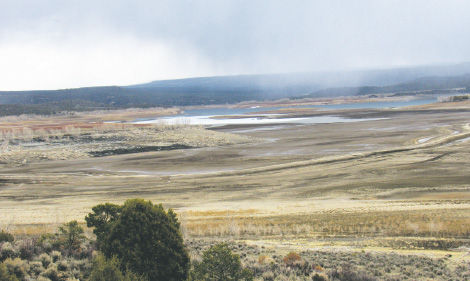 It’s 1956, we are driving our car across the Mexican border into Nogales, Sonora. Look, there is a parking place near some shops. We get out, lock the car and immediately a young boy comes up and offers to “watch our car” for us. He will “protect” it for 50 cents until we get back. We had some fairly nice hub caps so decided it was a wise investment, so gave him $1 to make sure. He did well, our hub caps were still there when we got back. Yeah, we knew it was a protection racket. Then there are the stories of the mob offering to “protect” a small business from a known arsonist in the area, for a small cost. It only took one who refused the “protection” for the others to decide to “hire” the services.
It’s 1956, we are driving our car across the Mexican border into Nogales, Sonora. Look, there is a parking place near some shops. We get out, lock the car and immediately a young boy comes up and offers to “watch our car” for us. He will “protect” it for 50 cents until we get back. We had some fairly nice hub caps so decided it was a wise investment, so gave him $1 to make sure. He did well, our hub caps were still there when we got back. Yeah, we knew it was a protection racket. Then there are the stories of the mob offering to “protect” a small business from a known arsonist in the area, for a small cost. It only took one who refused the “protection” for the others to decide to “hire” the services. Not the first idea that comes to mind? Too long, too wet, too…dangerous? Well, skip the lessons on using sextants and the correct way to jibe, and grab a copy of Bound for the Horn by Durango-area resident R.J. Rubadeau.
Not the first idea that comes to mind? Too long, too wet, too…dangerous? Well, skip the lessons on using sextants and the correct way to jibe, and grab a copy of Bound for the Horn by Durango-area resident R.J. Rubadeau.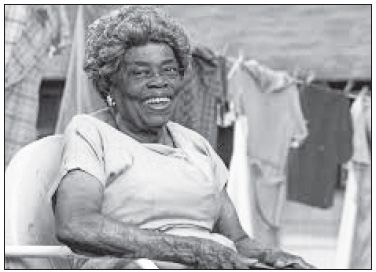



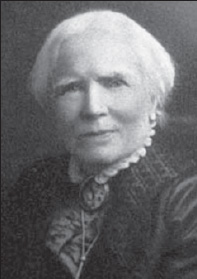

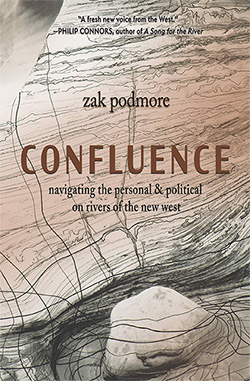 The frightening moment, which happened before Podmore was born when his mother was 25 years old, became a legend in family lore. Young Zak was born and raised to run rivers; he rode his first currents in a child’s car seat strapped to the wooden deck of an Army surplus raft.
The frightening moment, which happened before Podmore was born when his mother was 25 years old, became a legend in family lore. Young Zak was born and raised to run rivers; he rode his first currents in a child’s car seat strapped to the wooden deck of an Army surplus raft.
